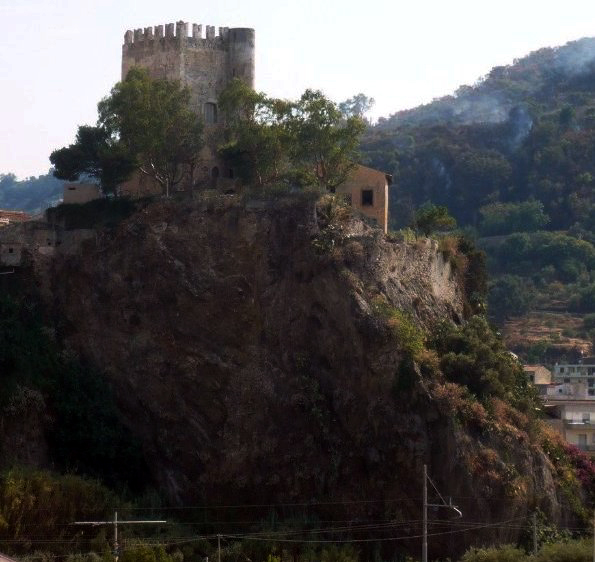Brolo

In Roman times this district was known as Brolium, while Roger Hauteville in 1094 mentioned the area in one of his privileges. To the Arabs it was Voab,
or sea fortress. This suggests that there was a castle here
protecting the port before the Normans arrived after 1060. The
port which was finally destroyed by floods in 1593 and 1682, which
resulted in much silting and the formation of the current flood plain,
leaving the castle isolated from the sea.
It is claimed that Bianca Lancia (d.1246), the mistress and allegedly briefly wife of the Emperor Frederick resided here and that her son, King Manfred (d.1266), was born here. Regardless, Bianca seems to have died at Paterno and had her major fortress at Mount Sant'Angelo on the mainland. Manfred was born at nearby Venosa.
The Lancias seem to have acquired the site when the Swabians took
over Sicily in 1197 or soon afterwards. Galvano Lancia (d.1268),
the brother of Bianca, is though to have been lord here when he was
also governor of Messina. In 1339 Hugh Lancia (d.1343), the great grandson of Galvano, was lord of Brolo as well as governor of Messina.
Above the main entrance
to the bailey is a stone carrying a crescent moon, the lion rampant of
the Lancia, three circles for the barony of Piraino and 8 circles for
the barony of Alagona. Obviously this single stone cannot be
older than the latest arms. There is also an inscription stating
that King Manfred was born here. The castle, along with Galati castle, were confiscated from Perrucchio and Corrado Lancia in 1392 by King Martin after their opposition to his rule, but they were returned in 1402.
In 1943 the Americans staged an amphibious landing here to outflank the
determined German defence to the west. This heavily damaged the
fortress, but such damage has been largely rebuilt.
Description
The castle sits upon a boss of rock overlooking the sea and consists of
a small 4 storey rectangular tower surrounded by a triangular curtain
wall. The wall is much rebuilt and built into, having been
reconstructed in the fifteenth century when it was redesigned for
firearms. The base of the wall to the south has a fine batter and
consists in part of fine ashlar masonry. The older parts are
rubble built with fine quoins at the corners. There are entrances
to east and west, though both are rebuilds.
The tower is rectangular and has a later circular stair turret
attached. The tower has 4 floors, the first and second floors
having barrel vaults, while the third has a cross vault surmounted with
the Lancia arms.
The whole was again repaired in the seventeenth century and after
1943. Although many of the arches within the tower are Romanesque
or at least near-Romanesque, they appear to be much later
insertions. The spiral stair within the stair turret is also a
late replacement. However the rubble masonry of the walls is
packed with many Roman tiles, which suggests an early, possibly
Byzantine date for the tower. However the castle bears some
resemblance to the Roman fortlet at Scarborough in England.
Without firm dating evidence it is difficult to guess as to when the
tower was started. A list of putative Byzantine castles in Sicily
can be found under Aci.
Within the castle now are the Museum of the Coastal Fortifications of Sicily and the Historical Museum of Torture.
Why not join me at other Sicilian castles?
Information on this and other tours can be found at Scholarly
Sojourns.
Copyright©2019
Paul Martin Remfry

